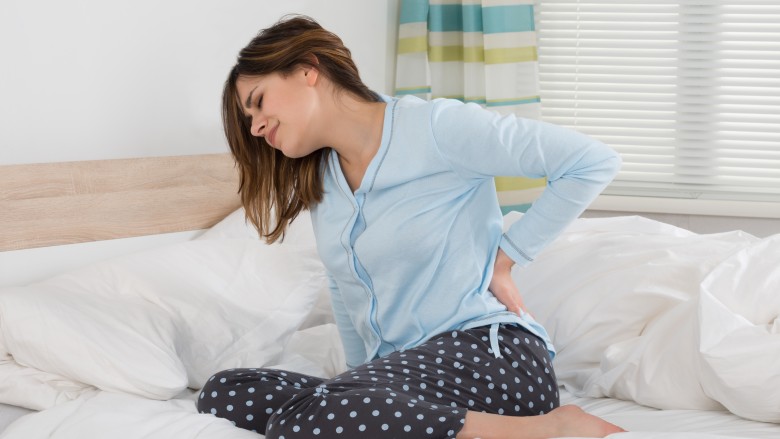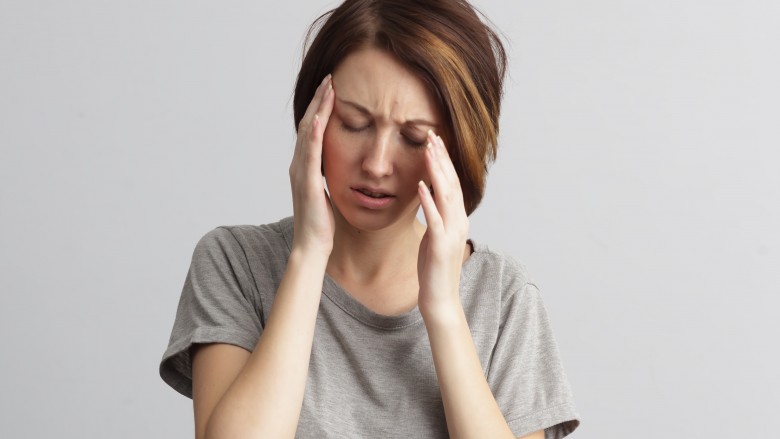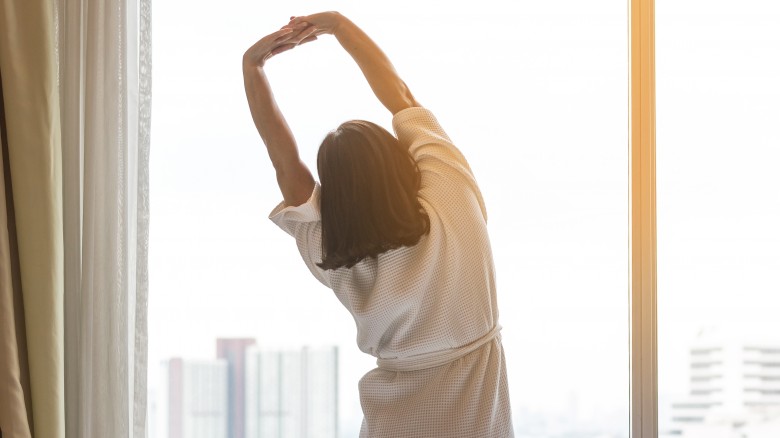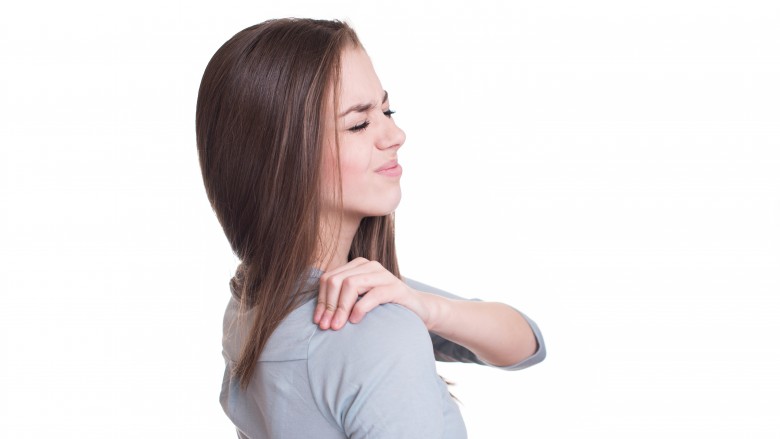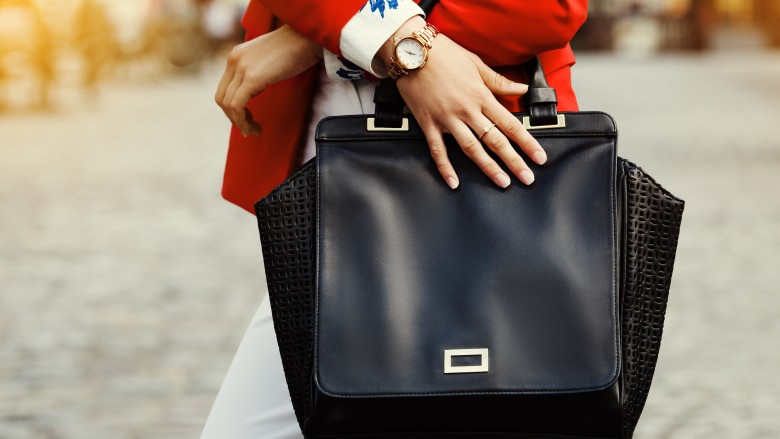What Happens To Your Body When Your Purse Is Too Heavy
We have all been culprits when it comes to the crime of carrying too heavy a purse. We love our giant totes and being able to accommodate all our essentials. We've been taught that it's always better to be prepared, so it seems only right to pack our purses to the brim — just in case. So what if we carry around those heavy bags for a few hours here or there. It couldn't have that much of an effect on our bodies, right? Wrong.
Several studies show just how much our fabulous purses can affect our day-to-day lives. According to the London Express (via CBS News), although it's trouble, it's also quite the trend. Some medics have called the condition "poshitis," named after Victoria "Posh Spice" Beckham who has often been seen rocking a large tote bag. We'd all love to think we have Posh Spice's style and the Mary Poppins' mystery bag that can fit every item and barely weigh a thing, but that concept is straight out of the movies.
Let's take a look at just what really happens to your body when your purse is too heavy, as well as a few tips and tricks to avoid those pesky purse problems in the future.
The overall strain and stress
Carrying a heavy purse can have extreme effects on our bodies. But when we say "heavy," just how much do these handbags weigh? Physiologist Sammy Margo broke it down for CBS News, discussing an experiment she performed with women between the ages of 21 and 55. She weighed their bags and found the heft to be between 8 to 22 pounds. As CBS described it, this is "about the size of a newborn to a 1-year-old." We're carrying all of that weight around on a daily basis? No wonder we're feeling the burn.
Not only is that a big load to lug, Margo described how our day-to-day lives — combined with the weight — are creating serious problems. She said, "We're leading such sedentary lifestyles...We're so much weaker than ever. Then, we carry this heavy weight for a prolonged time causing undue stress and strain."
On a similar note, Dr. Robert A. Hayden, a chiropractor and founder of The Iris City Chiropractic Center in Atlanta, described a big reason for the unnecessary pain with The Huffington Post. When you have a heavy purse, it causes muscles in your spine to work to offset the weight, which leads to more pressure on the lower back. As Hayden discussed with the publication, "The more asymmetric the load, the more everything below the shoulder will have to work."
Headaches are common
When we think of carrying heavy items, neck and back pain feel like a common consequence for this action. But it actually goes even further than that, as studies show that heavy purses can even lead to headaches. How does that even happen?
The Huffington Post spoke with chiropractor Dr. Karen Erickson who broke down the reason for the tension headaches. It goes back to the fact that the muscles are forced to help with supporting the weight. She described, "When the muscles in your shoulder and neck area spasm, it can cause pain in the back of your skull that radiates around to the front." So how can you know for sure if a headache is due to your larger tote? Dr. Oz (via WellBuzz) hints that if your bag weighs more than 10 pounds, it's probably having an effect. And if you find that your headache is located mainly on one side of your head, it's likely due to the weight of your purse.
It throws off your natural gait
Another common effect when we carry a heavy handbag has to do with our overall body balance. Loading so much weight on one side of our bodies definitely impacts us over time. Dr. Erickson delved deeper into the subject, saying, "One of the consequences of carrying a shoulder bag on one shoulder is that it significantly interferes with the normal gait," or, how our arms and legs naturally swing while walking. Having a heavy weight on one side of our bodies for a long time results in that side of the body not being able to swing in the natural way. This has a serious effect on the body's overall balance.
Although the bag's weight causes enough trouble, certain articles of clothing can throw off the normal gait even more. Akhil Chhatre, M.D., an assistant professor of physical medicine and rehabilitation at the Johns Hopkins University School of Medicine, spoke with NY Mag about this fact, sharing that wearing any clothing that affects your range of motion can have a negative effect. And the hardest part to hear? Your heels can be causing some serious problems too. Dr. Chhatre told the magazine that heels alter your gait and cause an even bigger effect when the weight of your purse is also involved.
Shoulder and neck muscles tighten up
So what about the muscles that have to work hardest to support our heavy loads? Dr. Erickson continued, saying that our purses can cause the trapezius muscle at the top of our shoulders, to spasm and tighten. This then travels to the base of the neck. She said, "When that happens, it can cause a lot of stiffness in the upper back, the shoulder area and the neck." So what kind of lasting effects can this have? It can cause "military neck," which is a decreased curve in the neck. And even beyond that, Dr. Erickson brought up the possibility of arthritis. "We also see people who develop arthritis in their neck, in their lower neck, because their neck has been forced to carry this heavy weight for such a long period of time."
And it's not just holding our purses on our shoulders that creates issues. When we rock them at the crook of our elbow, the effects are not much better. Dr. Andrew Rokito, who is an associate professor at the department of orthopedic surgery and chief of shoulder and elbow surgery at NYU Langone Medical Center in New York, said, "If you're balancing it or suspending it in the crook of your elbow, all of the weight is fixed at one point, placing quite a bit of downward traction on the shoulder...It has to be countered by the forces and muscles of not only your upper arm but the muscles of your shoulder as well."
Keep an eye on your posture
So what can you do to solve these problems? Start with your purse posture. Chiropractor Scott Bautch, of Wausau, Wisconsin, who worked to develop ACA guidelines on heavy bags, spoke with the Albuquerque Journal about one simple rule everyone should follow. He said, "I just think you need to get a bag that's as small as possible. Don't let it get past 5 to 8 pounds...Look in the mirror when you put on your bag. If you carry a bag and it makes you look different; if you can't stand up straight or are fighting to do so, then you're in trouble."
Things looking a little janky in the mirror? Sometimes it's as easy as balancing yourself out. Dr. Chhatre spoke with NY Mag about "the purse-and-tote-bag model of living." If you have your purse on one side of your body, carry a tote on the other. He calls this plan "a treatment modality," or, "introducing an equal weight on the opposite side of the body to balance the load." A great idea, but just make sure both sides aren't too heavy, which can cause overall strain.
Pick a new purse
Sometimes the solution will be finding a fabulous new purse that happens to be better for your body. One key way to do this: find a purse with a wider strap. Dr. Hayden says, "The wider the strap, the better." A wider strap creates an overall wider surface-contact area, allowing the weight to be distributed more evenly. He continued on to say that this protects the sensitive area of your body where your nerves go from your neck into your arm. "That's a pretty delicate area in terms of potential injury from heavy weight."
So just how wide should your purse strap be? Prevention Magazine offered a few tips, saying, "Look for one that's at least 2 inches across to disperse weight evenly. A narrow strap concentrates force." One purchase that ends up helping your body and overall health? Seems like some justified retail therapy!
Make time for strength training
Be sure to make some time for strength training to help build up those muscles that can support your large tote. We often think of stretches and workouts for the lower back and abs, but the shoulder blades are just as important. Neal Elattrache, M.D., a specialist at Los Angeles's Kerlan-Jobe Orthopaedic Clinic, broke this down during an interview with Oprah.com, saying, "Boys are taught to walk in a shoulders-back, chest-out posture...whereas that has not been considered a modest posture for women, so the shoulders come forward."
He continued on to address the issue that at the gym women then tend to only work out the arm muscles. He said, "It's a cascade of events that's headed for a problem...Carrying that purse is the final insult." So what can be done to remedy the situation? Dr. Elattrache recommends an exercise that can either be done with a fitness band or in a swimming pool. During the interview, he instructed to "keep upper arms at sides, elbows bent 90 degrees, start with palms facing each other, almost touching. Slowly bring both hands out to the side, pinching your shoulder blades as you press them together against resistance; then return to the starting position." He recommends two sets of 10 repetitions every day, or every other day, to start to make a difference.
Live with a little less
And now it's time for a compromise. We don't want to ditch our fabulous totes and purses, but we also need to stop straining our bodies. Robin Ehrlich, the director of the Eastside Massage Therapy Center in New York City spoke of this very fact with The New York Times, saying, "It's like telling a woman, 'You cannot wear Manolo Blahniks'...It's just not realistic." So what is the best way to rock the beloved purse? It's key to constantly remove items.
Marta Callotta, a chiropractor in Long Beach, California, told The New York Times that she "advises patients to clean out their purses once a week, and to use all the pockets so that the weight is dispensed evenly within the bag." It's so easy to let our purses stock up with items from our daily lives, but making habit of cleaning them out each week not only helps your body but also keeps you more organized. Sounds like a win-win to us!

